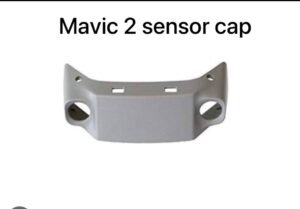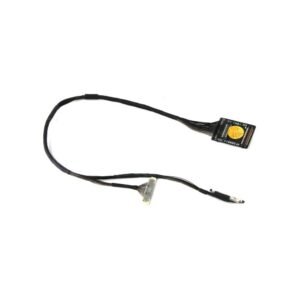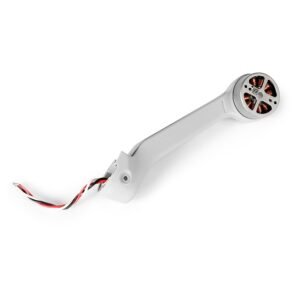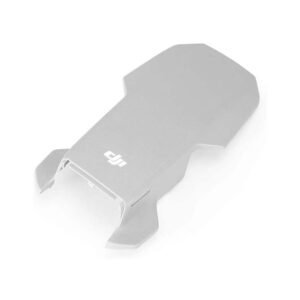Help Center
Help Center
₹5,000.00 Original price was: ₹5,000.00.₹3,999.00Current price is: ₹3,999.00. inc. Gst
Product Overview
| Brand | DJI (OEM) |
| Model | Gimbal Yaw Arm with Motor |
| Product Type | Gimbal Yaw Axis with Motor |
| Compatibility | DJI Air 2S |
| Material | High-strength composite plastic and metal |
| Condition | Used – Very Good (functionality tested and quality assured) |
| Package Includes | 1 x Gimbal Yaw Arm with Motor |
| Installation | Requires professional skills and tools |
| Calibration | Gimbal calibration is needed post-installation |
| Operating Temp Range | -10°C to 40°C |
In stock
The DJI Air 2S Yaw Arm Motor is the part that allows your drone’s camera to smoothly rotate left and right. It controls the horizontal movement of the gimbal, letting your camera follow subjects or pan through landscapes. Without this motor, the drone wouldn’t be able to smoothly change its direction during flight videos. If your camera shakes or stops turning sideways, this motor might need replacement. It is designed by DJI especially for the Air 2S and ensures perfect balance, correct rotation, and smooth video recording. Whether you’re repairing damage or upgrading parts, this motor restores your drone’s original movement with factory-quality precision.
This yaw arm motor gives your drone the ability to turn its camera left or right smoothly while flying. This sideways movement is very important when you want to capture a wide scene, follow a moving subject, or create a cinematic pan effect in your videos. It rotates gently and gradually without any shaking, helping the camera to stay balanced while changing direction. This results in more professional and clean-looking shots during flights, no matter the location or subject. The smooth rotation also helps the drone to stay better oriented while tracking, especially during intelligent flight modes.
This yaw motor is not a generic part—it is made by DJI specifically for the Air 2S. That means it fits exactly into the drone’s gimbal system without needing extra tools or modifications. All the connectors, screws, and placements are the same as the original. Using a compatible motor made by the same brand ensures proper communication with the drone’s internal software and control system. It also ensures better flight stability and reduces the risk of mechanical failure in the long term. The part is fully tested to meet DJI’s factory standards of performance and durability.
The motor housing is made of strong and heat-resistant materials that protect the inner components during long flights. Whether you are flying in the sun or in slightly windy conditions, this motor continues to perform without overheating or losing speed. The motor is sealed properly to keep out dust and moisture, and its outer structure is built to handle everyday vibrations. Because of this, the motor lasts for many months of regular flying if used carefully. The better protection also means you won’t need to replace it often, saving you time and money on future repairs.
The yaw motor works silently while rotating the camera, which is important when you are recording audio or flying in quiet environments. It doesn’t produce any buzzing or clicking sounds, and its internal design prevents vibrations that can affect the gimbal’s smoothness. Whether you’re capturing a nature scene or flying indoors, this motor allows the camera to move steadily without adding noise or shake to your video. This silence and stability are especially helpful when filming professional content or using sensitive microphones near the drone.
This yaw arm motor is easy to install if you’re experienced with drone repairs, or can be replaced by a technician quickly. Since it’s made exactly for the Air 2S, you don’t have to struggle with size or wiring mismatches. The motor fits into the gimbal assembly using standard DJI screws and plugs into the control board using its original connector. Once it is secured properly, the drone recognizes it immediately. A quick gimbal calibration afterward ensures everything works just like it did when the drone was brand new from the box.
First, make sure your drone is powered off and the battery is removed to avoid any electrical damage or short circuits during installation.
Carefully remove the gimbal cover and unscrew the damaged yaw motor using a small precision screwdriver, making sure not to touch other parts.
Disconnect the old motor’s cable from the circuit board without pulling too hard or bending the wires, then take it out of the gimbal assembly.
Insert the new yaw motor in the same slot and connect the wire into the board exactly as it was before, ensuring a firm connection.
Secure the motor in place with screws, reattach the gimbal cover, and perform a gimbal calibration in the DJI Fly app before your next flight.
Gently wipe the surface of the yaw motor with a dry, clean microfiber cloth after every few flights to remove dust or dirt that may collect.
Avoid using water, wet tissues, or any spray cleaners directly on the motor, as moisture can damage internal electronics and motor bearings.
If you notice dust in tight corners, use a soft-bristled brush or small air blower to clean without applying pressure to the rotating parts.
Always hold the gimbal gently when cleaning the motor area, and never twist or pull the motor arm while wiping to avoid damaging its rotation.
Clean the motor regularly, especially after flying in sandy, dusty, or coastal areas, to maintain its performance and prevent long-term wear.
Avoid crashing the drone or flying it into tight spaces, as sudden impacts can directly damage the yaw motor or dislodge its internal gear.
Keep your drone inside a hard case or padded bag during travel to prevent the gimbal and motor from being bent or pressed during transport.
Do not attach extra weight or third-party accessories to the gimbal, as this puts pressure on the yaw motor and can reduce its lifespan.
Try to fly in calm weather when possible, as strong wind makes the gimbal work harder, which can strain the yaw motor over time.
After long flights, let the drone cool down for a few minutes before packing it away to prevent heat buildup in the motor area.
Do:
Use only original DJI replacement parts for the yaw motor to ensure full compatibility and safety during use.
Calibrate the gimbal after replacing the yaw motor to align it with the rest of the drone’s control system and sensors.
Handle the motor with clean, dry hands when installing or cleaning to avoid introducing oils or moisture near the connection points.
Fly your drone carefully when the gimbal is newly repaired to make sure the motor functions correctly under real flying conditions.
Regularly inspect the motor’s rotation by slowly moving the gimbal left and right to feel if the movement is smooth and responsive.
Don’t:
Don’t rotate the camera arm by force when the drone is powered off or on—it can damage the gears inside the yaw motor assembly.
Don’t skip calibration after installing a new yaw motor, as this can cause shaky footage or unwanted camera movements during flight.
Don’t spray compressed air too closely or with strong force directly into the motor, as this can push dust further inside instead of removing it.
Don’t install the motor if you are unsure of the wiring or placement—get professional help to avoid electrical or mechanical damage.
Don’t ignore warnings in the DJI Fly app like “gimbal overload” or “calibration needed” after motor replacement—these are signs of setup issues.
If your DJI Air 2S camera isn’t rotating smoothly or is giving gimbal errors, the yaw arm motor may be worn out or damaged. This original replacement motor restores perfect camera movement, ensuring buttery-smooth left and right motion for your videos. It is silent, powerful, and built to last. With the correct fit and DJI-approved quality, it gets your drone back to full performance without worry. Fly smooth, shoot sharp, and keep your footage cinematic with a motor that works exactly the way it should.
| Specification | Details |
|---|---|
| Brand | DJI |
| Model | Gimbal Yaw Arm with Motor |
| Product Type | Gimbal Yaw Axis with Motor |
| Compatibility | Specifically designed for DJI Air 2S drones |
| Material | Constructed from high-strength composite plastic and metal for durability |
| Condition | Used – Very Good (disassembled from used drones, functionality tested, and quality assured) |
| Package Includes | 1 x Gimbal Yaw Arm with Motor |
| Installation Requirements | Professional skills and tools are required for installation |
| Calibration | Post-installation gimbal calibration is necessary using professional software |
| Operating Temperature Range | -10°C to 40°C |
| Notes | Ideal for replacing damaged yaw arms due to crashes or wear; not recommended for novices |

In stock

In stock

In stock

In stock
Reviews
There are no reviews yet.